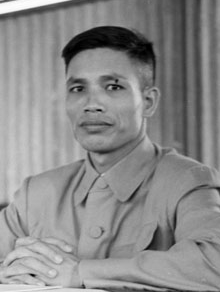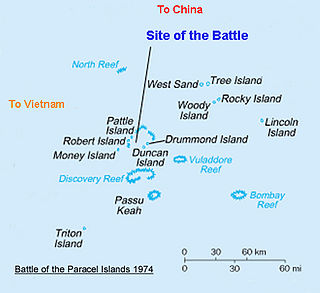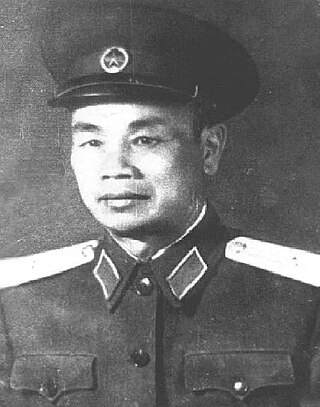| Ambassador of Vietnam to China | |
|---|---|
| Inaugural holder | Hoàng Văn Hoan |
| Formation | January 1, 1950 |
The Vietnamese ambassador in Beijing is the official representative of the Government in Hanoi to the Government of the People's Republic of China.
| Ambassador of Vietnam to China | |
|---|---|
| Inaugural holder | Hoàng Văn Hoan |
| Formation | January 1, 1950 |
The Vietnamese ambassador in Beijing is the official representative of the Government in Hanoi to the Government of the People's Republic of China.
| Diplomatic agreement/designated/Diplomatic accreditation | Ambassador | Observations | List of prime ministers of Vietnam | Premier of the People's Republic of China | Term end |
|---|---|---|---|---|---|
| January 18, 1950 | The governments in Hanoi and Beijing established diplomatic relations. | Hồ Chí Minh | Zhou Enlai | ||
| January 1, 1950 | Hoàng Văn Hoan | Hồ Chí Minh | Zhou Enlai | January 1, 1957 | |
| January 1, 1958 | Nguyễn Khang (politician) | Phạm Văn Đồng | Zhou Enlai | January 1, 1958 | |
| January 1, 1959 | Trần Tử Bình | 1963 Vietnamese Ambassador to China Tran Tu Binh, Republic has appointed Tran Tu Binh to replace Nguyen Khang as Ambassador Extraordinary and Plenipotentiary to China. Tran Tu Binh left here for Peking yesterday. [1] | Phạm Văn Đồng | Zhou Enlai | January 1, 1967 |
| May 13, 1967 | Ngô Minh Loan | was an alternate member of the VWP CC 1960–76, and Vietnamese ambassador to Beijing 1967–69. [2] | Phạm Văn Đồng | Zhou Enlai | November 26, 1969 |
| January 2, 1970 | Ngô Thuyen | Phạm Văn Đồng | Zhou Enlai | ||
| January 1, 1973 | Tran Binh | Charge d'affaires [3] | Phạm Văn Đồng | Zhou Enlai | |
| July 5, 1976 | Nguyễn Trọng Vĩnh | Nguyen Trong Vonh [4] | Phạm Văn Đồng | Zhou Enlai | January 1, 1987 |
| February 17, 1979 | Sino-Vietnamese War | China's War with Vietnam, 1979 On 3 July a Chinese note to the Vietnamese embassy in Beijing announced that remaining aid to Vietnam had been cancelled, an act which was seen by Pravda as anattempt to coerce Vietnam into surrendering to the great power ambitions | Phạm Văn Đồng | Hua Guofeng | March 16, 1979 |
| March 16, 1990 | Đặng Nghiêm Hoành | Hoanh, Dang Nghiem (* November 24, 1934 in Hon Gai) [5] | Đỗ Mười | Li Peng | January 1, 1997 |
| December 29, 1997 | Bui Hong Phuc | [6] | Phan Văn Khải | Li Peng | |
| January 27, 2003 | Tran Van Lust | [7] | Phan Văn Khải | Wen Jiabao | |
| September 19, 2008 | Nguyen Van Tho | [8] | Nguyễn Tấn Dũng | Wen Jiabao |
Coordinates: 39°54′47″N116°26′46″E / 39.912977°N 116.446002°E [9]

Phan Khắc Sửu was a South Vietnamese engineer and politician who served as a minister in Bảo Đại's government of the State of Vietnam and as a civilian Chief of State of South Vietnam from 1964–65 during the rule of the various military juntas.

Văn Tiến Dũng, born Co Nhue commune, Từ Liêm District, Hanoi, was a Vietnamese general in the People's Army of Vietnam (PAVN), PAVN chief of staff (1954–74); PAVN commander in chief (1974–80); member of the Central Military–Party Committee (CMPC) (1984–86) and Socialist Republic of Vietnam defense minister (1980–87).

Quảng Bình, formerly Tiên Bình under the reign of Lê Trung Hưng of the Lê dynasty, is a province along Vietnam's north-central coast. The province has an area of 8,065.8 square kilometers and population of 857,818 inhabitants The province is bordered by the Laotian Khammouane province to the west, the North Pacific Ocean to the east, Hà Tĩnh province to the north and Quảng Trị province to the south. Historically, this region belonged to Văn Lang and later the kingdom of Champa. Later it was claimed by both the Đại Việt and Champa and officially annexed into Đại Việt by Lý Thường Kiệt, a Lý dynasty general.

Vietnam competed at the 1980 Summer Olympics in Moscow, USSR. This was the first participation in the Olympics by the nation following the end of the Vietnam War and the Reunification of Vietnam.

Binh Xuyen Force, often linked to its infamous leader, General Lê Văn Viễn, was an independent military force within the Vietnamese National Army whose leaders once had lived outside the law and had sided with the Việt Minh. During its heyday, Bình Xuyên funded itself with organized crime activities in Saigon while effectively battling Communist forces.

The Battle of the Paracel Islands was a military engagement between the naval forces of China and South Vietnam in the Paracel Islands on January 19, 1974. The battle was an attempt by the South Vietnamese navy to expel the Chinese navy from the vicinity. The confrontation took place towards the end of the Vietnam War.

The Battle of Ba Gia was a major battle that marked the beginning of the Viet Cong's (VC) Summer Offensive of 1965, during the early phases of the Vietnam War. The battle took place in Quảng Ngãi Province, South Vietnam, between May 28–31, 1965.
Trần (陳) or Tran is a common Vietnamese surname. More than 10% of all Vietnamese people share this surname. It is derived from the common Chinese surname Chen.

Trần Tử Bình (1907–1967) was a Vietnamese revolutionary who later became one of the first generals of the Democratic Republic of Vietnam (1948) and Vietnam's Ambassador to People's Republic of China (1959–1967).

Emperor Quang Trung or Nguyễn Huệ, also known as Nguyễn Quang Bình, was the second emperor of the Tây Sơn dynasty, reigning from 1788 until 1792. He was also one of the most successful military commanders in Vietnam's history. Nguyễn Huệ and his brothers, Nguyễn Nhạc and Nguyễn Lữ, together known as the Tây Sơn brothers, were the leaders of the Tây Sơn rebellion. As rebels, they conquered Vietnam, overthrowing the imperial Later Lê dynasty and the two rival feudal houses of the Nguyễn in the south and the Trịnh in the north.
The Vietnam University of Fine Arts is an art school in Hanoi, Vietnam originally established under French colonial rule in 1925. The university has trained many of Vietnam’s leading artists and each year it participates in many cultural exchanges with sister institutions overseas.

Bình Minh is a town of Vĩnh Long Province, in the Mekong Delta region of Vietnam. Under the decree No 89/NQ-CP dated Dec 28, 2012, the cabinet of Vietnam SR decided to upgrade Bình Minh of Vĩnh Long to town from rural district.

Hoàng Kế Viêm (1820–1909) was a Vietnamese General and a Dong'ge Grand Secretariat during the Nguyễn dynasty. He played a significant role in suppressing borderlands banditry and resisting French invasion during the second half of the 19th century.

Gia Bình is a township and capital of Gia Bình District, Bắc Ninh Province, Vietnam.

Bình Ngô đại cáo was an announcement written by Nguyễn Trãi in 1428, at Lê Lợi's behest and on Lê Lợi's behalf, to proclaim the Lam Sơn's victory over the Ming imperialists and affirm the independence of Đại Việt to its people.
The 7th Military Region of Vietnam People's Army, is directly under the Ministry of Defence of Vietnam, tasked to organise, build, manage and command armed forces defending the South East Vietnam.

Hoàng Văn Thái, born Hoàng Văn Xiêm, was a Vietnamese Army General and a communist political figure. His hometown was Tây An, Tiền Hải District, Thái Bình Province. During the Tết Offensive, he was the highest senior North Vietnamese officer in South Vietnam. He was the first chief of staff of the Vietnam People's Army, and was responsible for key military forces in North Vietnam. He was also Chief of Staff in the Battle of Điện Biên Phủ.
The following is a list of political organizations and armed forces in Vietnam, since 1912:
The Central Intelligence Office was the national strategic intelligence agency for the government of the Republic of Vietnam, headquarters in Saigon. It was created in 1961, via Executive Decree No. 109/TTP, signed into law on May 5, 1961, by President Ngô Đình Diệm. The agency was responsible for investigating, gathering and analyzing strategic & military intelligence information on communist North Vietnam, and its branch in South Vietnam, the Viet Cong, and report and advise the South Vietnamese government on national security.

The government of the Nguyễn dynasty, officially the Southern Court and commonly referred to as the Huế Court, centred around the emperor as the absolute monarch, surrounded by various imperial agencies and ministries which stayed under the emperor's presidency. Following the signing of the Patenôtre Treaty the French took over a lot of control and while the government of the Nguyễn dynasty still nominally ruled the French protectorates of Annam and Tonkin, in reality the French maintained control over these territories and the Nguyễn government became subsidiary to the administration of French Indochina. During World War II the Japanese launched a coup d'état outsting the French and establishing the Empire of Vietnam which was ruled by the Nguyễn government. During the August Revolution the Nguyễn government was abolished in the aftermath of World War II.